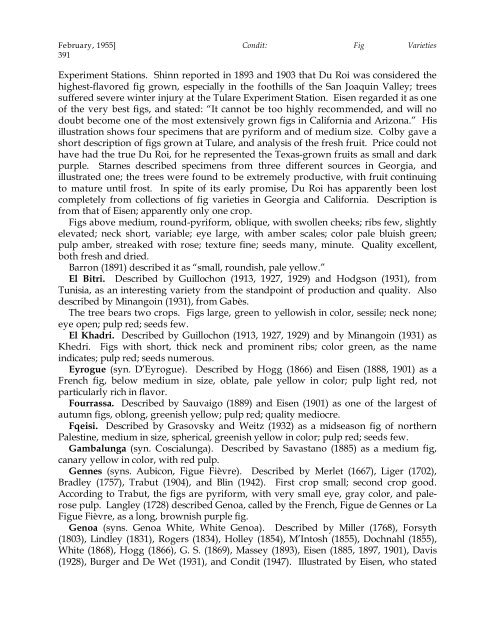Fig Varieties: A Monograph - uri=ucce.ucdavis
Fig Varieties: A Monograph - uri=ucce.ucdavis
Fig Varieties: A Monograph - uri=ucce.ucdavis
Create successful ePaper yourself
Turn your PDF publications into a flip-book with our unique Google optimized e-Paper software.
February, 1955] Condit: <strong>Fig</strong> <strong>Varieties</strong><br />
391<br />
Experiment Stations. Shinn reported in 1893 and 1903 that Du Roi was considered the<br />
highest-flavored fig grown, especially in the foothills of the San Joaquin Valley; trees<br />
suffered severe winter injury at the Tulare Experiment Station. Eisen regarded it as one<br />
of the very best figs, and stated: “It cannot be too highly recommended, and will no<br />
doubt become one of the most extensively grown figs in California and Arizona.” His<br />
illustration shows four specimens that are pyriform and of medium size. Colby gave a<br />
short description of figs grown at Tulare, and analysis of the fresh fruit. Price could not<br />
have had the true Du Roi, for he represented the Texas-grown fruits as small and dark<br />
purple. Starnes described specimens from three different sources in Georgia, and<br />
illustrated one; the trees were found to be extremely productive, with fruit continuing<br />
to mature until frost. In spite of its early promise, Du Roi has apparently been lost<br />
completely from collections of fig varieties in Georgia and California. Description is<br />
from that of Eisen; apparently only one crop.<br />
<strong>Fig</strong>s above medium, round-pyriform, oblique, with swollen cheeks; ribs few, slightly<br />
elevated; neck short, variable; eye large, with amber scales; color pale bluish green;<br />
pulp amber, streaked with rose; texture fine; seeds many, minute. Quality excellent,<br />
both fresh and dried.<br />
Barron (1891) described it as “small, roundish, pale yellow.”<br />
El Bitri. Described by Guillochon (1913, 1927, 1929) and Hodgson (1931), from<br />
Tunisia, as an interesting variety from the standpoint of production and quality. Also<br />
described by Minangoin (1931), from Gabès.<br />
The tree bears two crops. <strong>Fig</strong>s large, green to yellowish in color, sessile; neck none;<br />
eye open; pulp red; seeds few.<br />
El Khadri. Described by Guillochon (1913, 1927, 1929) and by Minangoin (1931) as<br />
Khedri. <strong>Fig</strong>s with short, thick neck and prominent ribs; color green, as the name<br />
indicates; pulp red; seeds numerous.<br />
Eyrogue (syn. D’Eyrogue). Described by Hogg (1866) and Eisen (1888, 1901) as a<br />
French fig, below medium in size, oblate, pale yellow in color; pulp light red, not<br />
particularly rich in flavor.<br />
Fourrassa. Described by Sauvaigo (1889) and Eisen (1901) as one of the largest of<br />
autumn figs, oblong, greenish yellow; pulp red; quality mediocre.<br />
Fqeisi. Described by Grasovsky and Weitz (1932) as a midseason fig of northern<br />
Palestine, medium in size, spherical, greenish yellow in color; pulp red; seeds few.<br />
Gambalunga (syn. Coscialunga). Described by Savastano (1885) as a medium fig,<br />
canary yellow in color, with red pulp.<br />
Gennes (syns. Aubicon, <strong>Fig</strong>ue Fièvre). Described by Merlet (1667), Liger (1702),<br />
Bradley (1757), Trabut (1904), and Blin (1942). First crop small; second crop good.<br />
According to Trabut, the figs are pyriform, with very small eye, gray color, and palerose<br />
pulp. Langley (1728) described Genoa, called by the French, <strong>Fig</strong>ue de Gennes or La<br />
<strong>Fig</strong>ue Fièvre, as a long, brownish purple fig.<br />
Genoa (syns. Genoa White, White Genoa). Described by Miller (1768), Forsyth<br />
(1803), Lindley (1831), Rogers (1834), Holley (1854), M’Intosh (1855), Dochnahl (1855),<br />
White (1868), Hogg (1866), G. S. (1869), Massey (1893), Eisen (1885, 1897, 1901), Davis<br />
(1928), Burger and De Wet (1931), and Condit (1947). Illustrated by Eisen, who stated
















![Fig Trees in North Carolina [Archive] - IDigMyGarden ... - Figs 4 Fun](https://img.yumpu.com/26905320/1/190x245/fig-trees-in-north-carolina-archive-idigmygarden-figs-4-fun.jpg?quality=85)